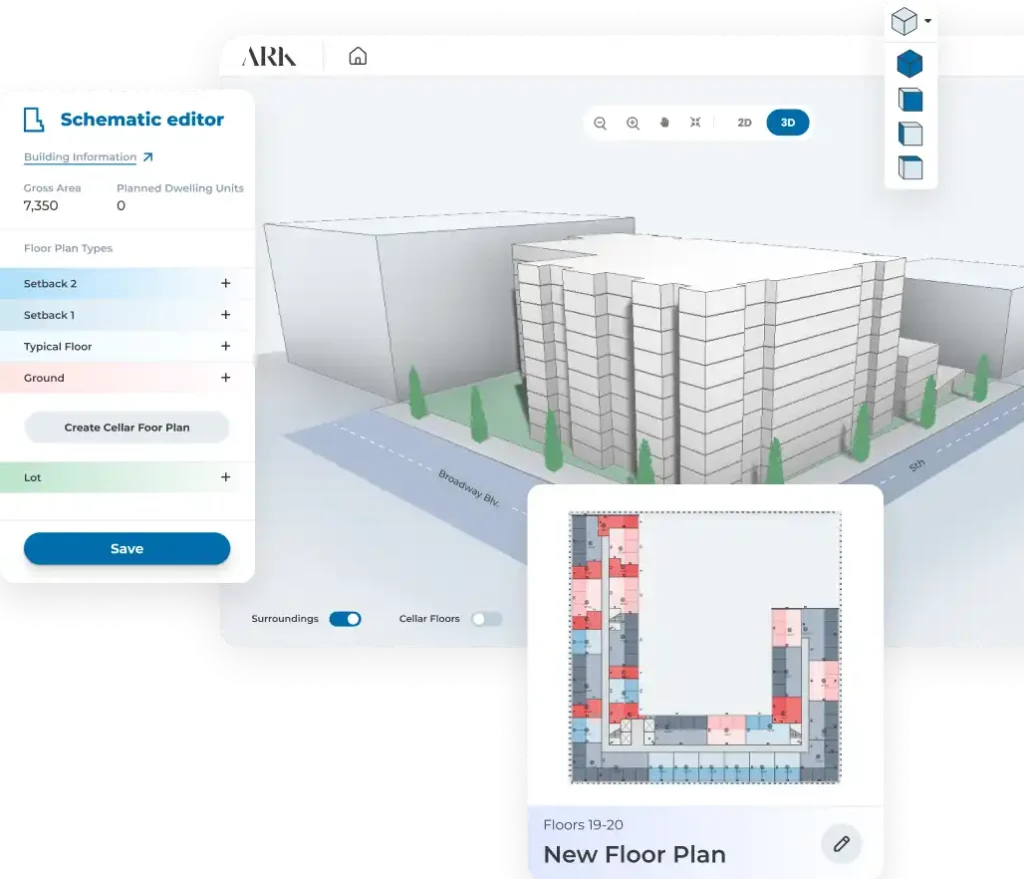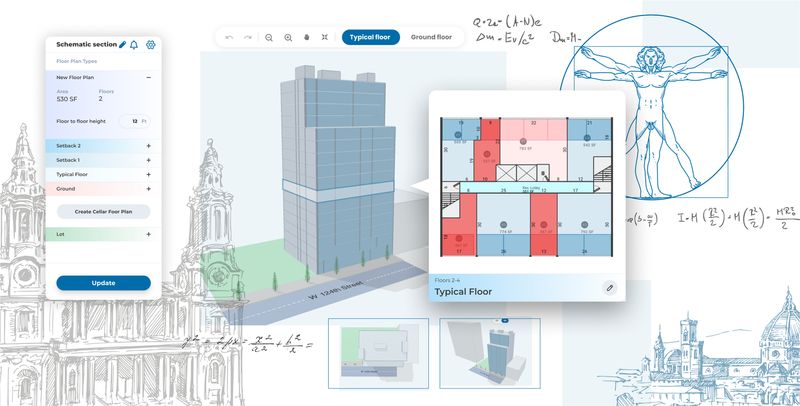Revolutionizing Architectural Design: How ArkDesign.AI Transforms Schematic Planning for Dubai’s Smart Developments


1. Website Summary
The ArkDesign.AI platform (found at arkdesign.ai) describes itself as an AI-powered solution for schematic architectural design, focused particularly on multi‐family and mixed‐use developments. (Ark Design)
Key features and claims include:
-
Automated generation of floor plans and feasibility reports for multi‐family / mixed‐use projects. (Ark Design)
-
Optimization of profitability, density, living standards while aligning with building codes and ordinances (in the US context). (Ark Design)
-
A workflow that lets users input lot/zone data, floorplate options, core layout, unit mix, etc., and then generate optimized schematic layouts. (aec+tech)
-
Export options to further design tools (e.g., PDF, Revit) for downstream design. (aec+tech)
-
Free trial option, plus paid Pro/Enterprise tiers. (aec+tech)
-
A claim of U.S. Patent No. 11,972,174 for their technology. (Ark Design)
So, in summary: ArkDesign.AI positions itself as a generative‐design tool for architects and developers, enabling rapid schematic studies, early design exploration and feasibility analysis.
Key Products / Systems
From the site and third‐party descriptions:
-
Lot editor / lot type input (interior, corner, etc.) with adjacencies, streets, yards. (aec+tech)
-
Floor plate editor: ground & typical floor layout selection; shape, size, massing. (aec+tech)
-
Core/circulation editor: specify shafts, vertical circulation, set constraints. (aec+tech)
-
Automated floor‐plan generator: taking constraints (unit types, window walls, unit count) and generate optimized layouts. (aec+tech)
-
Feasibility reports: area summaries, unit‐mix analysis, profitability/efficiency metrics. (aec+tech)
-
Export and downstream BIM integration (Revit export stated). (aec+tech)
How It Benefits Architects
For architects (and consultants/contractors) the benefits can include:
-
Speed: early schematic studies normally take quite a bit of manual effort; this tool promises to reduce that time dramatically.
-
Exploration: the ability to rapidly generate multiple schematic layouts and assess unit mix, building massing, yields, etc.
-
Optimization: using AI to balance unit count, profitability, efficiency, and living quality (window access, circulation, etc.).
-
Feasibility alignment: early alignment with code and zoning constraints—reducing risk of invalid schematic layouts.
-
BIM continuity: export to Revit means that the schematic work can be carried into design development rather than discarded.
-
Cost‐efficiency: less time wasted on options that turn out to be non‐feasible; better use of architectural time for creativity rather than repetitive schematic editing.
2. Specification & CSI MasterFormat Reference
Given that ArkDesign.AI is a software platform for schematic design, the relevant CSI MasterFormat division is in the 03 Programming & Planning or perhaps 00 Procurement & Contracting Requirements when thinking broader; but more specifically for architectural software tools, one might refer to Division 01 – General Requirements or Division 25 – Integrated Automation (for building automation software). However this is really a software service rather than a materials/systems component.
In AEC contracts in Dubai (and globally) one might treat this as a Design Software Service rather than a physical product. For the sake of specification, you would reference Division 01 11 00 – Summary of Work (since this tool supports schematic design) and perhaps Division 01 33 00 – Submittal Procedures (for design deliverables).
Alternatively, you might specify Section 01 78 00 – Closeout Submittals if you are detailing software output deliverables.
Aligning with Dubai Consultant Specifications
In Dubai, architectural consultants often require deliverables such as schematic design floor‐plans, massing studies, unit mix reports, compliance with local regulations (DDA – Dubai Development Authority guidelines, DM – Dubai Municipality zoning, Dubai Building Code). Using a tool like ArkDesign.AI supports this by providing schematic layouts and feasibility data early in the process. When specifying it in a consultant's schedule you might indicate:
-
“Use ArkDesign.AI (or equivalent) for schematic layout generation – produce at least 3 alternative layouts with unit mix and area summaries.”
-
Ensure that the output deliverables include: site plan, floor‐plate studies, typical floor plan, elevation/massing, unit mix table, area schedule, yield summary.
-
Link to the Dubai building regulations: for example, ensure that natural light, window/ventilation setbacks, exit access, fire stairs, and corridor geometry comply with Dubai Building Code and Dubai Municipality standards.
-
Specify that the software output must be exported as Revit (or equivalent) models for further design development, and ensure model coordination with the consultant’s BIM standards.
3. Advantages & Limitations in Dubai Market Context
Advantages
-
Rapid schematic iteration: In the fast pace of Dubai real estate developments, being able to test multiple scenarios quickly (e.g., different unit mixes, different massing envelopes) is a major advantage.
-
Optimising yield and density: Given that land costs are high in Dubai, optimizing saleable area, unit count, efficiency are critical. ArkDesign.AI’s capability to generate optimized layouts aligns well.
-
Early compliance checking: If the tool can check code/ordinance compliance (though currently US‐based) it reduces risk of redesign later.
-
Integration with BIM workflow: Dubai consultants often require BIM deliverables. The ability to export to Revit is a plus.
-
Feasibility for mixed‐use: Dubai developments often involve multi-family, mixed‐use podiums, high-rise apartments. The tool’s focus is aligned with those project types.
Limitations and Considerations
-
Code/regulation localization: The tool appears to be oriented primarily for US codes/ordinances. For use in Dubai, one must verify that the code logic aligns with UAE/Dubai regulations (e.g., fire escape distances per DDA, DM, Dubai Civil Defence rules).
-
Customization vs. creativity: While AI‐generated layouts can speed schematic design, architects may find limitations in bespoke architectural expression, unique forms or luxury villa typologies common in Dubai.
-
Market and unit typology differences: Dubai has its own market dynamics (studio, 1BR, 2BR, luxury penthouses, etc.). The unit mix optimisation should be set appropriately for local context rather than default settings.
-
Software subscription and training: Implementation requires training for the team, and making sure the deliverables are acceptable to all stakeholders (architect, developer, municipality).
-
Data export and coordination: While it supports Revit export, the downstream design team must ensure that the generated geometry works within the project's BIM standards, coordination with MEP/structure, etc.
-
Local technical support: Given that the company is US‐headquartered, local support in Dubai/UAE time zones might need to be confirmed.
4. Regulatory Context for Dubai
When specifying or approving the use of ArkDesign.AI (or any schematic design‐automation tool) in Dubai one should consider:
-
Dubai Building Code (based on the International Building Code 2015 with Dubai amendments) – ensure schematic layout from ArkDesign considers required egress, corridor geometry, fire stair proximity, maximum travel distances.
-
Dubai Municipality & Dubai Development Authority (DDA) – zoning regulations (floor area ratio, setbacks, podium levels, tower separation) must be fed into the tool to ensure the layout adheres.
-
Dubai Civil Defence requirements – ensure core placement, vertical shafts, egress, fire fighting access are accounted for in the automated layout.
-
Green/LEED/WELL standards – Dubai often requires sustainable design: daylighting, natural ventilation, façade optimisation. While ArkDesign.AI focuses on unit mix/efficiency, the architect must ensure that these sustainability parameters are integrated or overlaid after schematic generation.
-
BIM requirements – For many Dubai consultants, deliverables must comply with BIM execution plans (BEPS). The schematic model from ArkDesign.AI must integrate into the BIM chain (structure, MEP, facade) and use consistent classification (OmniClass/Uniclass) if required.
-
Contractual deliverables – The consultant’s scope should explicitly specify that the schematic design will be generated via ArkDesign.AI, and the submission must include the output files (pdfs, Revit) plus design narrative of unit mix, massing, area calculations, and optionally comparison of alternative scenarios.
5. How Architects/Consultants in Dubai Should Use ArkDesign.AI
Here is a recommended process workflow when using ArkDesign.AI within a Dubai project:
-
Project briefing & constraints gathering
-
Collect site information: plot boundaries, setbacks, surrounding context, zoning (FAR, height limit, podium restrictions) under Dubai Municipality or DDA.
-
Determine target program: number of units, unit types (studio, 1-BR, 2-BR, etc.), commercial/mixed‐use components, parking requirements.
-
Input code/standards parameters: egress travel distance, corridor widths, window/ventilation requirements as per Dubai Building Code and Civil Defence.
-
-
Initial setup in ArkDesign.AI
-
Create a new Lot and model the site context (interior lot, corner lot, etc.). (ArkDesign supports lot editor) (aec+tech)
-
Define shape of typical floor plate, number of floors, use (residential, mixed‐use).
-
Define core/circulation placement: vertical shafts, stair/elevator core, align for Dubai fire egress and shaft access.
-
-
Generate schematic layouts
-
Use ArkDesign’s automated floor plan generator to produce multiple options that meet constraints (unit mix, window access, core connectivity).
-
Export or view in 3D/massing view to verify height, setbacks, tower separation, daylight.
-
-
Evaluate and refine options
-
Review unit mix, area efficiency (net/net unit area vs gross floor area), corridor efficiency, saleable area.
-
Check compliance with local codes: e.g., daylight to units, unit depth limits, service core accessibility.
-
Choose preferred option(s). Modify as needed (adjust floorplate shape, setbacks, unit mix).
-
-
Export & hand‐off to design development
-
Export to Revit (or equivalent) and deliver to the design team (architect, structural, MEP) as schematic baseline.
-
Alongside deliverables include schedule of areas, unit mix table, feasibility report and rationale for layout choice.
-
-
Integration with Dubai deliverables
-
Submit schematic design to local authority/municipality if required (for example, preliminary approval stage).
-
Incorporate sustainability metrics (daylight, facade design, orientation) which may require additional tools beyond ArkDesign.AI.
-
Ensure BIM model aligns with consultant’s BIM standards and classification – cleaning up any auto‐generated geometry to ensure constructability downstream.
-
6. Final Insights
For architects, consultants and contractors in Dubai working on multi‐family and mixed‐use developments, ArkDesign.AI offers a compelling early‐stage schematic design tool that can accelerate decision‐making, enable rapid exploration and optimise layouts for yield and efficiency. It should, however, be viewed as a schematic support tool rather than a replacement for detailed design, code checking and local regulatory review.
When implemented properly—with clear constraints and local regulation inputs—it can reduce risk of costly redesigns, shorten the time to concept approval and enhance the developer‐architect collaboration on unit mix and profitability. It is important to treat the output as input to the design development stage, and verify all geometry, code compliance and feasibility assumptions in the local Dubai context.
Suggested Visual for the post
A strong photo would be a screenshot of ArkDesign.AI’s interface showing a generated floor plan or massing option side‐by‐side with unit mix table and area summary. Alternatively a rendered view of a Dubai‐style high‐rise residential tower with overlay of floorplate segmentation, showing how the tool can feed into the design.
References
-
ArkDesign.AI website: “AI-Powered Design & Feasibility Studies for Multi-Family & Mixed-Use Projects” (Ark Design)
-
aec+tech review: ArkDesign.AI overview, features, pricing etc. (aec+tech)
-
futurepedia tool description: ArkDesign review and key facts. (futurepedia)
-
ArkDesign LinkedIn page: tool orientation for architects & real estate. (LinkedIn)



Comments
Post a Comment